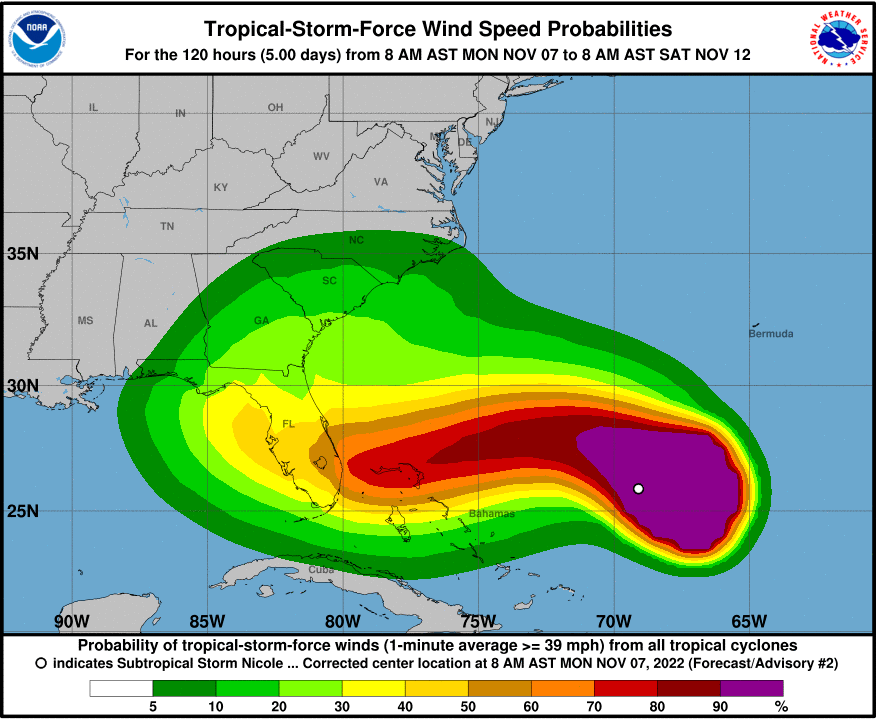Coast Guard prepares for Subtropical storm Nicole, warns of impacts
U.S. Coast Guard sent this bulletin at 11/07/2022 01:19 PM EST
| News Release |
U.S. Coast Guard 7th District Southeast |
Coast Guard prepares for Subtropical storm Nicole, warns of impacts

Editor's Note: Click on images to download high-resolution version.
MIAMI — Coast Guard Seventh District crews are preparing in advance of Subtropical Storm NICOLE’s forecast impact, Monday. A Tropical Storm Watch has been issued for NICOLE, which is expected to strengthen into a hurricane by Wednesday.
Hurricanes and tropical storms can be deadly, and the Coast Guard’s ability to conduct rescues can be diminished at the height of a storm. Emergency preparedness throughout hurricane season is critical to the safety of coastal residents and mariners.
Homeland Security Task Force – Southeast units are maintaining an active presence in the Caribbean and Florida Straits to prevent and deter irregular, illegal maritime migration, which can prove even more dangerous and deadly during hurricane season. Those attempting to enter the United States illegally by sea will be rescued and repatriated.
The National Hurricane Center warns that it is too early to predict the exact track or strength of NICOLE. Residents and mariners in the Caribbean, Bahamas, Florida, Georgia and South Carolina should ensure they have hurricane plans in place and closely monitor forecast updates by the NHC Atlantic and the National Weather Service.
As Subtropical Storm NICOLE continues to travel West through the Atlantic, the Coast Guard is reminding the public of these important safety messages and warnings:
- Atlantic hurricane season runs until November 30. There are multiple risk factors associated with tropical storms and hurricanes. Among them are strong wings, tornadoes, storm surge and heavy rain can cause flash flooding, riptides and coastal erosion.
- Stay off the water. The Coast Guard’s search and rescue capabilities degrade as storm conditions strengthen. This means help could be delayed. Boaters should heed weather watches, warnings and small craft advisories.
- Evacuate as necessary. If mandatory evacuations are set for an area, the public should evacuate without delay. Have a plan for your family and your pets. Coast Guard personnel and other emergency responders may not be able to evacuate or rescue those in danger during the storm.
- Secure belongings. Owners of large boats are urged to move their vessels to inland marinas where they will be less vulnerable to breaking free of their moorings or to sustaining damage. Trailerable boats should be pulled from the water and stored in a place that is not prone to flooding. Those who are leaving their boats in the water are reminded to remove EPIRBs and to secure life rings, lifejackets and small boats. These items, along with kayaks and paddleboards, can break free if not properly secured and divert valuable search and rescue resources to ensure people are not in distress.
- Stay clear of beaches. Wave heights and currents typically increase before a storm makes landfall. Even the best swimmers can fall victim to the strong waves and rip currents caused by hurricanes. Swimmers should stay clear of beaches until local lifeguards and law enforcement officials say the water is safe.
- Be prepared. Area residents should be prepared by developing a family plan, creating a disaster supply kit, having a place to go, securing their home and having a plan for pets. Information can be found at Ready.gov.
- Stay informed. The public should monitor the progress and strength of the storm through local television, radio and Internet. Boaters can monitor its progress on VHF radio channel 16. Information can also be obtained on small craft advisories and warnings on VHF radio channel 16.
- Florida is still recovering from the impacts of Hurricane Ian. Visit the Florida Division of Emergency Management’s website for information from the state.
- Para mantenerse actualizado sobre la Tormenta Subtropical NICOLE en Español, oprima aquí.
Up-to-date weather information can be found at https://www.weather.gov/. If you are in an evacuation or flood zone, follow the instructions from local emergency managers, who work closely with federal, state, local, tribal and territorial agencies and partners. They will provide the latest recommendations based on the threat to your community and appropriate safety measures. Visit https://www.ready.gov/hurricanes for more information on how to prepare for hurricane season.
Updated port conditions for hurricanes and tropical storms can be found at https://homeport.uscg.mil/. For more information about hurricanes and hurricane preparedness, visit NOAA’s and FEMA’s websites where you can find widgets that provide hurricane tracks and other updates. These may be found at www.ready.gov/hurricanes, www.nhc.noaa.gov, and www.fema.gov.
As a reminder, people in distress should use 911 to request assistance whenever possible, or VHF radio channel 16 for mariners. Social media should not be used to report distress.
For more breaking news, follow us on Twitter. For additional information, find us on Facebook and Instagram.
-USCG-

